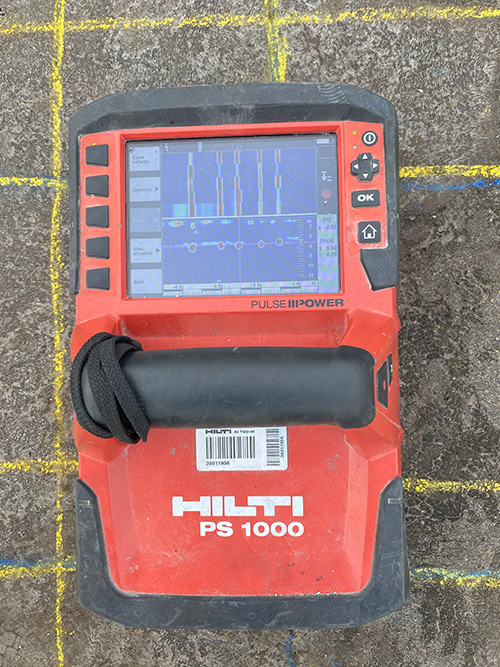Introduce the Transformative Power of Concrete Scanning in Making Best Use Of Efficiency and Safety
Concrete scanning has actually emerged as a vital device in the construction industry, using unmatched benefits in enhancing project efficiency and ensuring safety requirements. The transformative power of concrete scanning exists in its capability to provide real-time information and detailed insights, transforming exactly how jobs are intended and performed.
Relevance of Concrete Scanning
Making sure the architectural honesty and security of building tasks starts with the important step of carrying out detailed concrete scanning. Concrete scanning is a non-destructive method made use of to spot and map subsurface aspects within concrete structures. This process is necessary in recognizing prospective risks, such as rebar, post-tension cable televisions, and conduits, that may be hidden within the concrete. By using sophisticated modern technologies like ground-penetrating radar (GPR) and electro-magnetic induction, construction teams can properly find these elements without causing any damage to the structure.
Furthermore, concrete scanning helps in optimizing task timelines and budget plan by avoiding unanticipated prices and delays that may emerge due to unpredicted obstructions within the concrete. Ultimately, spending in comprehensive concrete scanning is an aggressive method that improves both performance and security in building tasks.
Just How Concrete Scanning Works
Concrete scanning operates as a crucial device in construction projects by using sophisticated modern technologies to discover and map subsurface components without creating structural damages. Ground Penetrating Radar (GPR) and Electromagnetic Induction (EMI) are two primary techniques utilized in concrete scanning.
Throughout the scanning procedure, the data gathered is assessed in real-time, permitting immediate identification of potential dangers or obstacles beneath the surface. This details aids in decision-making, making certain that building and construction activities continue safely and successfully. Furthermore, 3D imaging software application can be utilized to create comprehensive maps of the subsurface aspects, additionally improving task planning and execution. By employing these sophisticated technologies, concrete scanning considerably reduces the danger of expensive damages and injuries on building and construction sites.
Advantages of Concrete Scanning
Utilizing innovative scanning technologies in building and construction tasks provides a wide range of benefits, enhancing both performance and safety on-site. Among the main advantages of concrete scanning is the ability to discover and locate embedded items such as rebar, post-tension cords, and conduits precisely. By identifying these components prior to boring or reducing into concrete structures, the threat of accidental strikes is dramatically minimized, protecting against prospective injuries to workers and damage to the framework itself. Additionally, concrete scanning assists in preparation and developing more efficiently, as it offers accurate details concerning the place and deepness of structural components.

Study: Concrete Scanning Success

In one more case, a building and construction firm made use of 3D concrete scanning to assess the problem of aging concrete frameworks in a historical building. The comprehensive scans provided useful understandings into the level of degeneration and aided focus on maintenance initiatives effectively. By proactively attending to areas of problem identified with scanning, the business was able to extend the lifespan of the structure and guarantee resident safety and security.
These study underscore the transformative power of concrete scanning in improving effectiveness, precision, and safety and security in building tasks.
Carrying Out Concrete Scanning in Projects
Applying innovative scanning technologies throughout construction jobs has ended up being increasingly crucial for boosting precision and safety and security. By integrating concrete scanning into task preparation and implementation, building and construction teams can determine potential hazards, such as rebar or post-tension wires, concealed within concrete frameworks. This aggressive approach decreases the danger of crashes, hold-ups, and pricey rework, eventually resulting in more efficient project timelines and budgets.
To carry out concrete scanning successfully, job supervisors must collaborate carefully with experienced scanning experts to establish the most ideal scanning strategies for the certain task requirements. Involving scanning professionals from the onset of a task allows the group to produce comprehensive scanning plans that resolve vital areas of concern and make sure detailed data collection.
In addition, incorporating concrete scanning right into regular task workflows can simplify decision-making procedures, as real-time scan data provides instant understandings into the condition of concrete frameworks - Concrete Scanning. This data-driven method facilitates educated analytic and allows teams to make modifications immediately, cultivating a society of performance and security throughout the job lifecycle

Verdict
In conclusion, concrete scanning plays an important duty in improving performance and safety and security in construction jobs. By making use of innovative technology to find and map out underlying frameworks within concrete, this process assists to protect against costly mistakes, guarantee architectural honesty, and lessen dangers on website. With the capacity to reveal hidden elements and provide accurate data, concrete scanning shows to be a useful device for maximizing task outcomes Click Here and taking full advantage of general success.
Concrete scanning is a non-destructive approach made use of to detect and map subsurface elements within concrete structures. Additionally, concrete scanning helps in optimizing project timelines and budget by avoiding unexpected expenses and hold-ups that may occur due to unanticipated obstructions within the concrete. One noteworthy situation research blog entails a large improvement job where concrete scanning played a crucial duty in making certain project success.In another instance, a building and construction business used 3D concrete scanning to evaluate the condition of aging concrete structures in a historical structure. By integrating concrete scanning right into job planning and implementation, building and construction teams can identify possible dangers, such as rebar or post-tension cable televisions, hidden within concrete frameworks.
Comments on “Extensive Insights into Concrete Scanning Procedures”